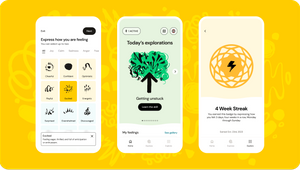
The Future of CX: If It Didn’t Move You, It Didn’t Matter

Every year, the first birthday card I receive comes from my dentist.
It arrives without fail - cheerful fonts, perfect timing, a reminder that somewhere, a CRM is doing its job. It’s technically thoughtful. But emotionally? It lands with the weight of a push notification. No matter how perfectly timed, I don’t feel seen. I feel sorted.
That’s the state of most brand experiences: optimised, efficient and utterly forgettable.
Over the past two decades, we’ve designed everything - from platforms to products to campaigns - for performance. We’ve removed friction, accelerated personalisation and scaled automation. We made systems that could do more, faster.
Somewhere along the way, we drew a line, deciding that emotion was the job of brand campaigns, not customer experiences. We’ve perfected how a film, tagline or image makes someone feel. But when it comes to CX or product, we settle for what works, defaulting to funnels over feelings. Flows over resonance. We’ve built digital systems that perform but don’t connect.
That disconnect shows up everywhere: in loyalty metrics that decline even as personalisation increases. In churn that rises despite anticipatory design. In moments that technically 'work' but leave no impression. We’ve made transactions seamless - but entirely unmemorable.
In the age of AI, those same systems are getting smarter - but not more human. Brands pour investment into co-pilots, chat layers and intelligent workflows, yet few can point to results that build trust, loyalty or meaning. There are plenty of demos but fewer outcomes. We’re measuring how well something works - but not whether it mattered.
People expect to feel something. Not just to be served but seen. Not just guided but understood.
This is the shift from Information Technology to Emotional Technology.
Information Technology is built for organisation, optimisation and control. It’s what made digital scale. But Emotional Technology will define the next era because people don’t return to what performed. They return to what moved them.
Emotional Technology is the intentional design of systems that move people - not just serve them. It’s where function meets feeling. Where emotional precision replaces generic personalisation. It doesn’t fake connection. It earns it.
Emotional Technology isn’t just layering a friendlier tone on top of a chatbot or adding a hero image to a platform. It’s about designing the infrastructure to resonate, to reassure, to stay with you. It treats emotional experience as a design problem, not just a marketing goal.
That paradigm shift can’t be layered on top of an experience. It has to be designed in.
At Code and Theory, we’ve created the Human Design Framework, a model for building emotional intelligence into brand systems’ foundations. The framework consists of three principles:
- Imagination → Creativity starts upstream, shaping the problem - not just polishing the execution.
- Control → With limitless tech capability, intention becomes strategy. What you choose not to do matters most.
- Orchestration → Cohesion is what makes emotion scalable. Every part of the system should support the story you want people to feel.
We’ve applied this across platforms, products and marketing ecosystems - for clients and in our own work. We’re not just making things look better; we’re making them feel better.
This is both a philosophical shift and a practical one. We’re working with clients to apply emotional design to the systems that matter most, across journeys, platforms and products. From generative UX to emotionally aware decision frameworks, we’re turning emotional resonance into a scalable design model, not just a marketing idea.
When everything in a system is built to evoke a feeling, that feeling lasts.
And in a world where everything performs, emotion is the edge.
If we want our brands to matter - to be remembered, trusted and chosen - we can’t just design for speed and utility. We need to design for emotional resonance. For meaning. For care.
We’ve made it frictionless. But if it’s forgettable, was it ever really progress?
Karen Piper is the head of brand strategy at Code and Theory.















